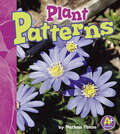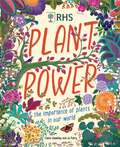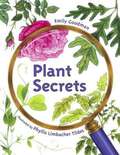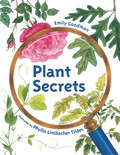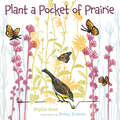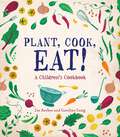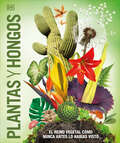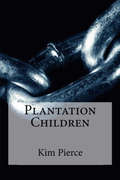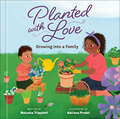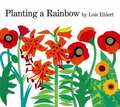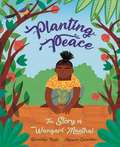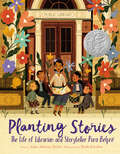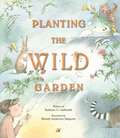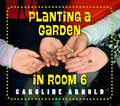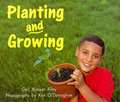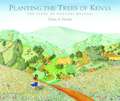- Table View
- List View
Plant Power: The Importance of Plants in our World
by Claire LlewellynPlants are amazing! They are found in every part of the world, growing from tiny seeds into beautiful blooms, gigantic trees and the delicious fruit and vegetables we eat. Plants are vitally important to humans, animals and even the climate, providing food, shelter, medicines and even helping to clean our planet's air and water. This book tells you everything you need to know about plants, from how they grow, reproduce and make their own food to the variety of ways that humans and animals use plants every single day.Readers can find out about plant parts and plant life cycles, pollination, food chains, photosynthesis, seeds and plant uses, such as in food, homes, furniture, musical instruments and medicines. We find out how plants can inspire us and how we need to protect plants so they can help protect us.This book is perfect for children aged 7+.
Plant Secrets
by Emily Goodman Phyllis Limbacher TildesPlants come in all shapes and sizes, but they go through the same stages as they grow. Using four common plants, young readers learn about a plant's life cycles.
Plant Secrets
by Emily GoodmanYoung scientists will love this nature mystery that reveals the secrets hiding in seeds, plants, flowers, and fruits throughout the life cycle of various flora. Curiosity will bloom in this introduction to botany and primary nature science. Plants come in all shapes and sizes, but they go through the same stages as they grow. Using four common plants, young readers learn about plant structure and life cycle. Simple text and colorful, detailed illustrations show the major phases of plant growth with each stage holding a &“secret&” for curious readers to guess. Back matter offers more information on each plant, as well as greater detail on each stage of growth.
Plant Signals: How and Why Plants Communicate (Fountas & Pinnell Classroom, Guided Reading Grade 6)
by Corey FlanniganMysterious Communications When hiking in a forest, we admire a redwood's beauty or a pine tree's fragrance. But what we don't notice are the trees' hidden talents. Trees and other plants can actually communicate with one another in surprising ways—and for fascinating reasons. NIMAC-sourced textbook
Plant a Kiss
by Amy Krouse RosenthalFrom the beloved New York Times bestselling author of Dear Girl, Amy Krouse Rosenthal, a simple and timeless celebration of the power of love.Little Miss planted a kiss...One small act of love blooms into something bigger and more dazzling than Little Miss could have ever imagined in this epic journey about life, kindness, and giving.Amy Krouse Rosenthal and Peter H. Reynolds team together to share a message of hope and to remind us all of the joys to be gained from being open and unselfish.Plant a Kiss works to spark the imagination of the youngest readers, but it will also resonate with anyone, such as a new graduate, who responds to the power of planting a kiss.
Plant a Pocket of Prairie
by Phyllis RootAuthor Phyllis Root and illustrator Betsy Bowen last explored the vast, boggy peatlands of northern Minnesota in their book Big Belching Bog. Now, in Plant a Pocket of Prairie, Root and Bowen take young readers on a trip to another of Minnesota&’s important ecosystems: the prairie. Once covering almost 40 percent of the United States, native prairie is today one of the most endangered ecosystems in the world. Plant a Pocket of Prairie teaches children how changes in one part of the system affect every other part: when prairie plants are destroyed, the animals who eat those plants and live on or around them are harmed as well. Root shows what happens when we work to restore the prairies, encouraging readers to &“plant a pocket of prairie&” in their own backyards. By growing native prairie plants, children can help re-create food and habitat for the many birds, butterflies, and other animals that depend on them. &“Plant cup plants,&” Root suggests. &“A thirsty chickadee might come to drink from a tiny leaf pool. Plant goldenrod. A Great Plains toad might flick its tongue at goldenrod soldier beetles.&” An easy explanation of the history of the prairie, its endangered status, and how to go about growing prairie plants follows, as well as brief descriptions of all the plants and animals mentioned in the story. With Betsy Bowen&’s beautiful, airy illustrations capturing the feel of an open prairie and all its inhabitants, readers of all ages will be inspired to start planting seeds and watching for the many fascinating animals their plants attract. What a marvelous transformation could take place if we all planted a pocket of prairie!
Plant and Animal Structures
by Linda CernakAnimal Structures, Plant Structures, Science and Engineering Practices, Careers.
Plant, Cook, Eat!: A Children's Cookbook
by Caroline Craig Joe ArcherFor beginners and green-thumbed foodies, this unusually all-inclusive garden-to-kitchen cookbook is part lesson in gardening and part collection of healthy, delicious, kid-friendly recipes.With vibrant photo-illustrations and clearly organized sections, discover how to plant seeds in patio containers, window boxes, or on an allotment; harvest fruits and vegetables; determine which plant parts are edible; spot pests in the garden; and use home-grown crops to cook everything from bean and bacon spaghetti to polenta chips to tomato, feta, and basil pizza."This effort offers budding young gardeners (and their adults) a comprehensive, hands-on guide to gardening and cooking" — Kirkus Reviews STARRED REVIEW
Plantar semillas: Celebrar la primavera (¡Arriba la Lectura!, Big Book Unit 1 #8)
by Kathryn ClayNIMAC-sourced textbook
Plantas carnívoras: Plantas que comen insectos (¡Arriba la Lectura!, Level O #14)
by Katie SharpNIMAC-sourced textbook
Plantas y hongos (Knowledge Encyclopedia Plants and Fungi!)
by DKExplora el maravilloso mundo de las plantas y los hongos, desde los cactus y las plantas carnívoras hasta los árboles, las flores y los hongos.¿Por qué las flores son coloridas y las frutas son dulces? ¿Cómo captura una planta carnívora a su presa? ¿Por qué pican las ortigas? ¿Cómo convierten los árboles la luz en alimento? Este libro sobre la naturaleza para niños fascinará a los lectores más jóvenes con detalles microscópicos y datos curiosos sobre el reino de las plantas y los hongos.En su interior, encontrarás: Datos, gráficos, líneas temporales e ilustraciones de una amplia gama de temas.Un enfoque visual único de las plantas y los hongos de todo el mundo, gracias a sus impresionantes y detalladas imágenes en 3D.Información valiosa que sirve de apoyo para los estudiantes de ciencias.¡La vida en la Tierra no podría existir sin plantas y hongos! Crean los alimentos que comemos y el oxígeno que respiramos, regulan el clima, proporcionan hábitats para los animales y producen recursos sostenibles que podemos usar para hacer libros, ropa, muebles y casas. Plantas y hongos muestra cómo estos seres vivos son los cimientos de todos los ecosistemas y hacen de nuestro planeta un lugar habitable. ¿A qué esperas para aprenderlo todo sobre los organismos imprescindibles para la vida en la Tierra?Explore the wonderful world of plants and fungi, with everything from cacti and carnivorous plants to trees, flowers, and mushrooms.Why are flowers colorful and fruits sweet? How does a carnivorous plant kill its prey? Why do stinging nettles sting? How do trees turn light into food? This ultimate nature book for children will fascinate young readers with its microscopic detail and amazing facts on the plant world. This all-encompassing nature encyclopedia for kids offers: A whole collection of facts, charts, timelines, and illustrations that cover a vast range of topics.Plants and fungi from around the world shown using amazingly detailed CGIs that entice young readers to dive in and explore.Important STEM topics covered in life sciences curricula.A visual approach using illustrations, photographs and extremely detailed 3D CGI images.Knowledge Encyclopedia: Plants and Fungi! shows how plants and fungi form the foundations of every ecosystem, making our planet habitable. Life on Earth couldn’t exist without plants and fungi. Plants create the food we eat and the oxygen we breathe. They regulate the climate, provide habitats for animals, and produce sustainable resources that we can use to make books, clothes, furniture and houses. Fungi are just as important.
Plantation Children
by Kim PierceTennessee, 1862. Fifteen-year-old Elizabeth Edwards hates her personal slave, Anna. Elizabeth has never given much thought to the plight of the slaves on her father's plantation; instead, she focuses on pretty dresses and horses, and dreams of the young man she wants to marry.But Elizabeth's world collapses when she is told she must marry her cousin to keep the plantation in the family. Elizabeth takes out her anger on Anna, who finally snaps and reveals that Elizabeth and she have the same father. Anna is brutally whipped the next day, and Elizabeth is horrified. When she tries to confide in her mother, she finds her secretly kissing Elizabeth's tutor.Elizabeth now feels she has nothing and nobody. She changes her attitude about Anna and asks her to run away with her. They are overheard by two stable hands, Fred and Sam, who have heard of a safe house on the Underground Railroad. The four of them set off, planning to reach Canada.Will they all make it to Canada alive? Does Anna truly forgive Elizabeth, or is she just using her? Is it possible to find love on the run?
Planted with Love: Growing into a Family
by Natasha TripplettA heartfelt picture book about one child's experience in foster care that reminds all kids that—just like a garden—love from the right source will help them bloom.Lamar has lived in seven homes in three years and has never stayed anywhere long enough to put down roots. As he watches his new foster mom tend to her garden each day, he soon joins her with cautious curiosity. Together, they plant, they weed, they water . . . until one day Lamar's anger and feelings of uncertainty lead him to destroy the garden.But through his foster mother's love and care, Lamar discovers that just like her garden, he is wanted, he is loved, he has been planted, and he will bloom.Written by a licensed social worker, Planted with Love illustrates that a loving home and a loving adult can provide a safe place for any child to grow and thrive.
Planting A Rainbow
by Lois EhlertThis educational and enjoyable book helps children understand how to plant bulbs, seeds, and seedlings, and nurture their growth. Lois Ehlert's bold collage illustrations include six pages of staggered width, presenting all the flowers of each color of the rainbow.
Planting Peace: The Story of Wangari Maathai
by Gwendolyn HooksThis is the inspiring story of Wangari Maathai, women's rights activist and one of the first environmental warriors. Overcoming great obstacles, Wangari began the Green Belt Movement in Kenya in the 1960s, which focused on planting trees, environmental conservation and women's rights. She inspired thousands across Africa to plant 30 million trees in 30 years, saving many from hunger and poverty. Her remarkable story of courage and determination shows how just one person can change the world.The story shows children how desertification works: how land is eroded and degraded when trees aren't there to hold the soil in place so it's not taken away by winds and heavy rain. It explains how all living things are dependent on each other and if trees are taken away, then you not only lessen the fertility of the soil, but you lose the animals that live there and then the animals that rely on those animals for food and so on.As well as explaining important green issues, the book also talks about Wangari's fight for human rights and shows how important it is to stand up for what you believe.The gripping narrative non-fiction text by Gwendolyn Hooks, winner of the NAACP Image Award for Outstanding Literary Work for Children, hooks readers from the start. Vibrant illustrations from print-maker Margaux Carpentier, one of the featured artists in Taschen's The Illustrator: 100 Best from around the World, vividly evoke Wangari's amazing life story.The consultant, Dr Jane Irungu, grew up in Kenya, but is now a Professor at the University of Oklahoma. She was inspired by Wangari when she was growing up and went on to get a PhD just as Wangari did. 'Carpentier's saturated geometric illustrations emphasize the bold impact of Maathai's actions', Publishers Weekly, May 2021
Planting Stories: The Life of Librarian and Storyteller Pura Belpré
by Anika Aldamuy DeniseRECIPIENT OF THE PURA BELPRÉ HONOR * A Today Show's Best Kids' Books of 2019 * Indie Next List Pick * Junior Library Guild Selection * “An appealing tribute and successful remedy to the lack of titles about the groundbreaking librarian...a must-have for all libraries.” —School Library Journal (starred review)An inspiring picture book biography of storyteller, puppeteer, and New York City’s first Puerto Rican librarian, who championed bilingual literature.When she came to America in 1921, Pura Belpré carried the cuentos folklóricos of her Puerto Rican homeland. Finding a new home at the New York Public Library as a bilingual assistant, she turned her popular retellings into libros and spread story seeds across the land. Today, these seeds have grown into a lush landscape as generations of children and storytellers continue to share her tales and celebrate Pura’s legacy.Brought to colorful life by Paola Escobar’s elegant and exuberant illustrations and Anika Aldamuy Denise’s lyrical text, this gorgeous book is perfect for the pioneers in your life.Informative backmatter and suggested further reading included.A Spanish-language edition, Sembrando historias: Pura Belpré: bibliotecaria y narradora de cuentos, is also available.“Anika Aldamuy Denise’s intimate telling captures the magical, folk-tale feeling of Belpré’s own stories. Her lyrical text, sprinkled like fairy dust with Spanish words, begs to be read aloud, while Paola Escobar’s stylishly detailed and warmly expressive illustrations capture the joy of sharing stories.” —New York Times Book Review
Planting a Garden in Room 6: From Seeds to Salad (Life Cycles in Room 6)
by Caroline ArnoldKindergarteners learn the joys of gardening in this close-up look at how plants grow.A visit to Mrs. Best's classroom is always inspiring! Follow a classroom of real kindergartners as they grow a garden full of healthy vegetables. Joyful photographs show kids planting seeds, tending the seedlings, and harvesting (and eating!) the results. An exciting introduction to the math and science involved in growing a garden. The Life Cycles in Room 6 series follows Mrs. Best&’s real kindergarten class as they help things grow. This photo-illustrated series engages readers with hands-on science in the classroom and beyond.
Planting a Rainbow (Fountas & Pinnell LLI Blue #Level F)
by Lois EhlertA mother and child plant a rainbow of flowers in the family garden.
Planting a Rainbow (Fountas & Pinnell LLI Blue: Level F)
by Lois EhlertThis educational and enjoyable book helps children understand how to plant bulbs, seeds, and seedlings, and nurture their growth. Lois Ehlert's bold collage illustrations include six pages that present all the flowers of each color of the rainbow.
Planting and Growing (Into Reading, Level E #26)
by Ken O'Donoghue Gail RileyNIMAC-sourced textbook
Planting the Trees of Kenya: The Story of Wangari Maathai
by Claire A. NivolaWangari Maathai, winner of the 2004 Nobel Peace Prize and founder of the Green Belt Movement, grew up in the highlands of Kenya, where fig trees cloaked the hills, fish filled the streams, and the people tended their bountiful gardens. But over many years, as more and more land was cleared, Kenya was transformed. When Wangari returned home from college in America, she found the village gardens dry, the people malnourished, and the trees gone. How could she alone bring back the trees and restore the gardens and the people? Bill McKibben, author of The End of Nature, says: “Wangari Maathai’s epic story has never been told better—-everyone who reads this book will want to plant a tree!” With glowing watercolor illustrations and lyrical prose, Claire Nivola tells the remarkable story of one woman’s effort to change the fate of her land by teaching many to care for it. An author’s note provides further information about Wangari Maathai and the Green Belt Movement. In keeping with the theme of the story, the book is printed on recycled paper.
Planting the Trees of Kenya: The Story of Wangari Maathai
by Claire A. NivolaWith glowing watercolor illustrations and lyrical prose, Claire Nivola tells the remarkable story of one woman's effort to change the fate of her land by teaching many to care for it. An author's note provides further information about Wangari Maathai and the Green Belt Movement. In keeping with the theme of the story, the book is printed on recycled paper.
